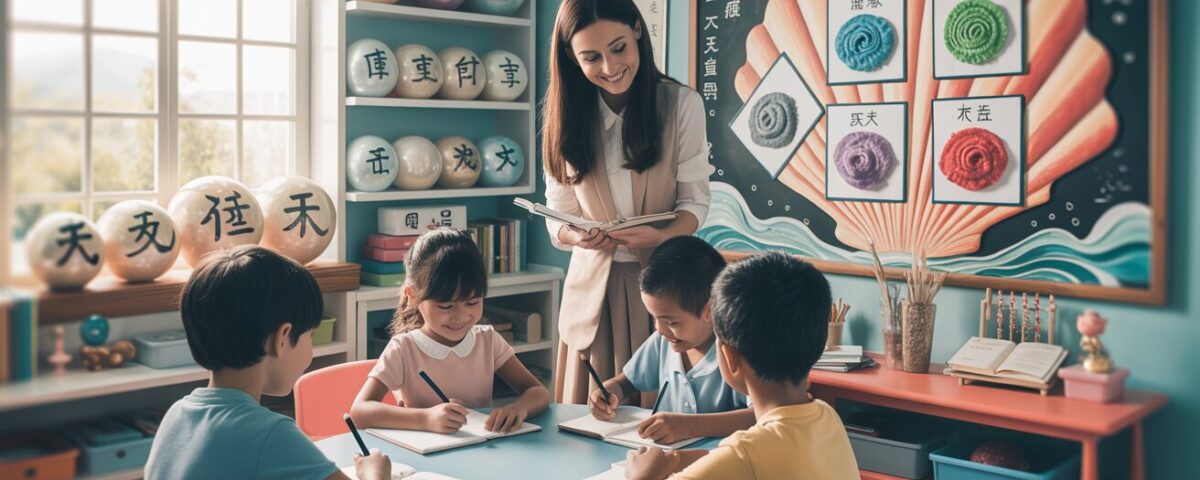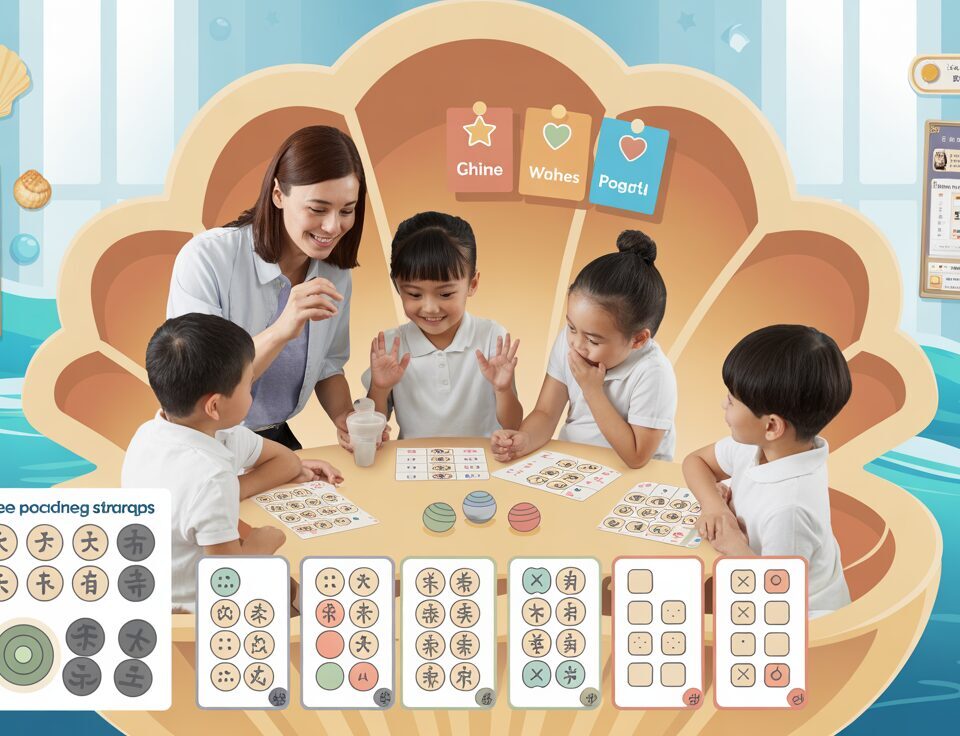
30 High-Impact Chinese Connectors for Better Composition: Master Essential Language Tools
November 3, 2025
Master Chinese Oral Pronunciation: Essential Tone Drills & Recorder Guide
November 4, 2025Table Of Contents
- Introduction
- Why Story Structure Matters in PSLE Chinese Composition
- Structure 1: The Mountain Climber (山爬者) – Problem-Resolution Framework
- Structure 2: The Circle of Life (生命之环) – Full Circle Narrative
- Structure 3: The Character Journey (人物旅程) – Transformation Arc
- Structure 4: The Lesson Learned (得到的教训) – Moral Revelation
- Applying These Structures in PSLE Chinese Composition
- Common Mistakes to Avoid
- Conclusion
Every compelling story has a backbone—a structure that guides readers through an engaging journey from beginning to end. For Primary 6 students facing the PSLE Chinese composition paper, mastering narrative structure isn’t just helpful—it’s essential for success. At Seashell Academy by Suntown Education Centre, we’ve observed how students who understand and apply effective story structures consistently score higher marks and develop greater confidence in their Chinese writing abilities.
The PSLE Chinese composition section often presents pictures or prompts that require students to craft original narratives under time pressure. Without a clear framework to organize their thoughts, many students struggle to develop coherent stories that showcase their language skills and creativity. The good news? Just like a pearl forms within the protective layers of a seashell, a well-structured story provides the perfect environment for your child’s ideas and Chinese language abilities to shine.
In this comprehensive guide, we’ll explore four proven story structures that have helped countless Seashell Academy students transform their Chinese narrative writing. These frameworks are specifically designed to align with PSLE requirements while providing flexibility for creative expression. Whether your child struggles with organizing thoughts or simply wants to elevate their composition to the next level, these structures offer practical scaffolding that makes Chinese writing more approachable, enjoyable, and successful.
4 Essential Story Structures for PSLE Chinese Narrative Writing
Master these proven frameworks to help your child excel in Chinese composition
Why Structure Matters
10 out of 40 PSLE composition marks are allocated specifically for content organization. A solid structure reduces cognitive load, enhances planning efficiency, builds writer confidence, and creates memorable narratives.
The Mountain Climber
Problem-Resolution Framework
Best for: Overcoming challenges, learning new skills, competitions, resolving conflicts
The Circle of Life
Full Circle Narrative
Best for: Personal growth, relationship development, changing perspectives, emotional transformation
The Character Journey
Transformation Arc
Best for: Moral themes, friendship challenges, narratives about values, difficult decisions
The Lesson Learned
Moral Revelation
Best for: Clear moral themes, stories about mistakes, social values, ethical choices
Common Mistakes to Avoid
Structural Pitfalls
- Imbalanced development
- Missing transitions
- Poor climax placement
- Inconsistent perspective
Content Issues
- Forced vocabulary
- Picture prompt neglect
- Thematic disconnection
- Character inconsistency
Emotional Development
- Telling not showing
- Emotional extremes
- Missing inner thoughts
Quick Structure Selection Guide
Action-Oriented Pictures
Sports, adventures, challenges → Mountain Climber Structure
Relationship-Focused Prompts
Family, friendship → Circle of Life Structure
Character-Centered Themes
Courage, persistence → Character Journey Structure
Value-Based Topics
Honesty, responsibility → Lesson Learned Structure
Structure is not a rigid formula but a flexible framework that supports your child’s unique voice and ideas.
Why Story Structure Matters in PSLE Chinese Composition
Before diving into specific structures, it’s important to understand why structure is so crucial for PSLE Chinese composition success. Many students possess adequate vocabulary and decent grammar skills but still receive mediocre scores. The missing element? A coherent structure that ties everything together.
The PSLE Chinese composition is typically worth 40 marks, with 10 marks allocated specifically for content organization. Examiners look for logical flow, clear progression, and appropriate paragraph divisions—all elements of strong structural foundation. Beyond the direct scoring impact, a well-structured composition enables students to showcase their language abilities more effectively, potentially boosting scores in other assessment areas as well.
Structure provides several key benefits that align perfectly with Seashell Academy by Suntown Education Centre’s holistic learning philosophy:
- Reduces cognitive load: When students have a framework to follow, they can focus more energy on language expression rather than worrying about what comes next
- Enhances planning efficiency: With limited planning time in examinations, having go-to structures saves precious minutes
- Builds writer confidence: Knowing how to organize a story reduces anxiety and builds the self-assurance essential for creative writing
- Creates memorable narratives: Well-structured stories leave stronger impressions on examiners, helping compositions stand out
At Seashell Academy, we’ve found that teaching structure alongside language skills creates a protective environment where students can develop their writing abilities without feeling overwhelmed—much like pearls forming within a seashell. Now, let’s explore four powerful structures that consistently help our students excel in PSLE Chinese narrative writing.
Structure 1: The Mountain Climber (山爬者) – Problem-Resolution Framework
The Mountain Climber structure is perhaps the most versatile and widely applicable framework for PSLE Chinese compositions. As its name suggests, this structure mimics the journey of climbing a mountain—starting at the base, encountering challenges during the ascent, reaching a climactic peak, and finally descending toward resolution.
Key Components
- 起步 (Beginning): Introduce the main character, setting, and establish a normal situation (approximately 2 paragraphs)
- 困难 (Problem): Present a challenge, conflict, or problem that disrupts the normal situation (1-2 paragraphs)
- 尝试 (Attempts): Show the character making one or more attempts to overcome the challenge, with increasing stakes (2-3 paragraphs)
- 高潮 (Climax): Present the most intense moment of the story, where the character faces the greatest difficulty (1 paragraph)
- 解决 (Resolution): Show how the problem is ultimately resolved, whether successfully or not (1 paragraph)
- 结束 (Conclusion): Reflect on the experience and what was learned (1 paragraph)
Example Application
For a PSLE picture composition showing children preparing for a school performance:
- 起步: Wei Ming is excited but nervous about being selected to perform a traditional Chinese dance for his school’s Cultural Day celebration
- 困难: During rehearsal, he struggles to remember the complex movements and feels embarrassed when he makes mistakes
- 尝试: Wei Ming practices at home but continues to struggle; he considers quitting but his grandmother offers to help, sharing that she performed the same dance in her youth
- 高潮: The day before the performance, Wei Ming freezes during the final rehearsal, feeling overwhelmed by pressure
- 解决: His grandmother’s encouraging words and shared family connection to the dance give him new confidence; he practices one final time with renewed purpose
- 结束: Wei Ming performs beautifully, connecting with his cultural heritage and gaining confidence in himself
When to Use This Structure
The Mountain Climber structure works exceptionally well for prompts involving:
- Overcoming challenges
- Learning new skills
- Facing fears
- School or sports competitions
- Resolving conflicts with friends or family
This structure’s clear progression makes it easy for examiners to follow and appreciate the narrative development, which is why our students at Seashell Academy’s P6 Chinese Programme often use it as their primary framework for examination compositions.
Structure 2: The Circle of Life (生命之环) – Full Circle Narrative
The Circle of Life structure creates a satisfying narrative by bringing the story back to where it began, but with meaningful change having occurred. This circular pattern creates a sense of completion that examiners find particularly appealing, as it demonstrates sophisticated narrative control.
Key Components
- 开始的场景 (Opening Scene): Establish a specific location, situation, or emotion (1 paragraph)
- 引出背景 (Background): Provide necessary context about the characters and their circumstances (1-2 paragraphs)
- 中心事件 (Central Event): Introduce the main action or incident that drives the story (2-3 paragraphs)
- 转折点 (Turning Point): Present a moment that changes the character’s perspective or situation (1-2 paragraphs)
- 回到开始 (Return to Beginning): Bring the narrative back to the same location or situation as the opening, but with a significant difference reflecting what has changed (1-2 paragraphs)
Example Application
For a PSLE composition with the theme “一次难忘的经历” (An Unforgettable Experience):
- 开始的场景: Mei Ling stands nervously at the entrance of the elderly care center, reluctant to enter for her first day of community service
- 引出背景: She was assigned this volunteer work as part of her school’s character development program but has always felt uncomfortable around elderly people
- 中心事件: Mei Ling is paired with Ah Ma Zhang, a seemingly grumpy resident who initially rejects her help; through persistent kindness, Mei Ling discovers Ah Ma’s love for traditional Chinese poetry and begins reading to her
- 转折点: When Ah Ma falls ill, Mei Ling realizes how much she has come to care for her; she creates a handwritten book of poems to cheer her up
- 回到开始: Six weeks later, Mei Ling stands at the entrance of the elderly care center, now eagerly rushing inside with a new collection of poems, looking forward to sharing them with Ah Ma and the other residents she now considers friends
When to Use This Structure
The Circle of Life structure is particularly effective for:
- Stories about personal growth
- Narratives involving relationship development
- Compositions about changing perspectives
- Tales of discovery or realization
- Stories that highlight emotional transformation
This structure is a favorite among students in our P5 Chinese Programme as they develop more sophisticated narrative techniques in preparation for PSLE.
Structure 3: The Character Journey (人物旅程) – Transformation Arc
Unlike the previous structures that focus on external events, the Character Journey structure emphasizes internal development. This approach highlights personal transformation, making it particularly powerful for compositions that explore emotions, relationships, and personal growth.
Key Components
- 初始状态 (Initial State): Establish the character’s starting mindset, belief, or emotional state (1 paragraph)
- 触发事件 (Triggering Event): Introduce an incident that challenges the character’s initial state (1-2 paragraphs)
- 内心挣扎 (Internal Struggle): Detail the character’s emotional response and internal conflict (2-3 paragraphs)
- 关键选择 (Crucial Choice): Present a moment where the character must make a decision that reflects their evolving perspective (1 paragraph)
- 新的理解 (New Understanding): Show the character’s transformed viewpoint or emotional state (1-2 paragraphs)
- 应用变化 (Applied Change): Demonstrate how this new understanding affects the character’s actions or relationships (1 paragraph)
Example Application
For a PSLE composition with the theme “诚实” (Honesty):
- 初始状态: Jun Kai believes that small lies are acceptable if they help avoid trouble; he regularly makes up excuses for incomplete homework
- 触发事件: When Jun Kai’s favorite possession (a watch from his grandfather) goes missing, his classmate Liang claims he hasn’t seen it, but Jun Kai notices suspicious behavior
- 内心挣扎: Jun Kai feels betrayed and angry, but gradually realizes this is how teachers must feel when he lies about homework; he reflects on times his own dishonesty has affected others
- 关键选择: When his teacher asks directly if he completed his project independently, Jun Kai faces a moment of truth—continue his pattern of small lies or embrace honesty despite consequences
- 新的理解: After choosing honesty, Jun Kai experiences relief and a new appreciation for truthfulness, recognizing that integrity feels better than temporary escape from consequences
- 应用变化: Jun Kai approaches Liang with compassion rather than accusation, creating space for his classmate to return the watch and begin rebuilding trust
When to Use This Structure
The Character Journey structure is ideal for:
- Moral-themed compositions
- Stories about friendship challenges
- Narratives exploring values like honesty, responsibility, or kindness
- Coming-of-age experiences
- Stories involving difficult decisions
Our educators at Seashell Academy by Suntown Education Centre have found this structure particularly effective for helping students connect emotional depth with language expression—a key component of our Programme Philosophy that emphasizes both academic excellence and emotional well-being.
Structure 4: The Lesson Learned (得到的教训) – Moral Revelation
The Lesson Learned structure focuses on delivering a clear moral message or insight, making it particularly effective for compositions that aim to demonstrate values and character development—elements highly valued in the PSLE Chinese curriculum.
Key Components
- 错误认知 (Misconception): Establish the character’s initial flawed understanding or behavior (1 paragraph)
- 行为模式 (Pattern of Behavior): Show examples of actions resulting from this misconception (1-2 paragraphs)
- 后果出现 (Consequences Emerge): Introduce negative outcomes of these actions (1-2 paragraphs)
- 关键启示 (Key Revelation): Present a pivotal moment that clearly reveals the error in thinking (1 paragraph)
- 领悟道理 (Understanding the Truth): Detail the character’s realization and new understanding (1-2 paragraphs)
- 实践教训 (Applying the Lesson): Show the character implementing this new wisdom (1 paragraph)
- 总结反思 (Concluding Reflection): Offer a thoughtful conclusion that reinforces the moral lesson (1 paragraph)
Example Application
For a PSLE composition with pictures showing children using technology:
- 错误认知: Xiao Ming believes that spending time on his computer game is harmless entertainment and more interesting than family activities
- 行为模式: He regularly ignores family conversations, rushes through meals to return to gaming, and postpones homework for “just one more level”
- 后果出现: Xiao Ming’s grades begin to slip; he misses an important family gathering preparation and his younger sister feels neglected when he won’t help with her Chinese homework
- 关键启示: During the family’s reunion dinner that he barely participated in preparing, Xiao Ming overhears his cousin describing feeling lonely despite having many online friends; he recognizes himself in this description
- 领悟道理: Xiao Ming realizes that virtual achievements provide temporary satisfaction but real relationships require presence and investment; he understands that balance is necessary
- 实践教训: He creates a reasonable schedule for gaming, prioritizes family meals without distractions, and sets aside time to help his sister with her studies
- 总结反思: Xiao Ming reflects that true happiness comes from meaningful connections and balanced priorities, not endless digital distraction
When to Use This Structure
The Lesson Learned structure works effectively for:
- Compositions with clear moral themes
- Stories about mistakes and consequences
- Narratives focusing on character development
- Topics related to social values and ethical choices
- Compositions addressing common childhood challenges
This structure aligns perfectly with the values-based approach to education emphasized at Seashell Academy’s P4 Chinese Programme, where students begin developing the narrative skills that will serve them throughout their primary education.
Applying These Structures in PSLE Chinese Composition
Understanding these four structures is just the beginning—successful application requires practice and adaptability. At Seashell Academy by Suntown Education Centre, we guide students through a systematic approach to implementing these frameworks effectively:
Quick Structure Selection
When faced with a PSLE composition prompt, students should spend 1-2 minutes determining which structure best fits the given pictures or theme. Consider these quick guidelines:
- For action-oriented pictures (sports, adventures, challenges): The Mountain Climber structure often works best
- For relationship-focused prompts (family, friendship): The Circle of Life structure creates emotional resonance
- For character-centered themes (courage, persistence): The Character Journey structure highlights personal growth
- For value-based topics (honesty, responsibility): The Lesson Learned structure delivers clear moral messages
Efficient Planning Process
Once a structure is selected, students should spend 3-5 minutes outlining their composition. Our Seashell Method encourages using mind-mapping approaches that connect the chosen structure to specific content elements:
- Identify key characters and their traits
- Map out the major plot points according to the chosen structure
- Note specific vocabulary and phrases to include (especially idioms and descriptive language)
- Plan paragraph breaks to align with structural components
Structural Flexibility
While these structures provide valuable frameworks, they should be adapted rather than rigidly followed. Encourage students to:
- Combine elements from different structures when appropriate
- Adjust the number of paragraphs based on composition length requirements
- Emphasize certain structural components that best match the specific prompt
- Incorporate their unique voice and creative ideas within the structural framework
The goal isn’t to create formulaic writing but to provide supportive scaffolding that allows students’ natural creativity and language abilities to flourish—much like how a seashell provides protection while the pearl develops its unique beauty.
Common Mistakes to Avoid
Even with strong structural knowledge, students often make specific mistakes that can impact their PSLE Chinese composition scores. At Seashell Academy by Suntown Education Centre, we proactively address these pitfalls:
Structural Pitfalls
- Imbalanced development: Spending too many paragraphs on the beginning and rushing through the middle and conclusion
- Missing transitions: Failing to create smooth connections between structural components
- Climax placement: Positioning the most intense moment too early or too late in the narrative
- Inconsistent perspective: Switching narrative viewpoints without intention
Content Integration Issues
- Forced vocabulary: Inserting advanced words or idioms that don’t naturally fit the context
- Picture neglect: Failing to incorporate all elements from provided picture prompts
- Thematic disconnection: Losing sight of the central theme while focusing on narrative events
- Character inconsistency: Creating characters whose actions contradict their established traits
Emotional Development Challenges
- Telling not showing: Stating emotions directly rather than revealing them through actions and dialogue
- Emotional extremes: Moving too quickly from one emotional state to another without realistic development
- Missing inner thoughts: Focusing exclusively on external events without providing insight into characters’ feelings
Through our Mathematics Programme and Chinese curricula, Seashell Academy consistently emphasizes structured thinking approaches that help students avoid these common pitfalls across subjects, creating more coherent and impactful writing.
Conclusion
Mastering these four story structures—the Mountain Climber, the Circle of Life, the Character Journey, and the Lesson Learned—provides Primary 6 students with powerful tools for PSLE Chinese narrative writing success. Just as a seashell creates the protective environment where a pearl can form, these structures create the ideal conditions for students’ Chinese language skills and creativity to flourish.
At Seashell Academy by Suntown Education Centre, we’ve witnessed countless students transform their writing abilities through structured approaches that balance technical skill with creative expression. Our Seashell Method integrates these narrative frameworks with personalized coaching, mind-mapping techniques, and emotional support—creating a learning environment where students develop both confidence and competence.
Remember that structure is not a rigid formula but a flexible framework that supports your child’s unique voice and ideas. With practice and guidance, these four structures will become natural tools that students can adapt to any composition prompt, allowing them to focus less on “what comes next” and more on expressing themselves effectively in Chinese.
As your child prepares for the PSLE Chinese composition, encourage them to practice applying these structures to various prompts. With consistent practice and the right guidance, narrative writing can transform from a daunting challenge into an opportunity for creative expression and academic success.
Ready to Transform Your Child’s Chinese Composition Skills?
At Seashell Academy by Suntown Education Centre, our experienced MOE-trained educators specialize in nurturing Primary school students’ Chinese language abilities through our unique Seashell Method. Our small class sizes ensure your child receives personalized attention while developing the narrative skills needed for PSLE success.
Contact us today to learn more about our P4, P5, and P6 Chinese Programmes and how we can help your child build confidence and excellence in Chinese narrative writing!





